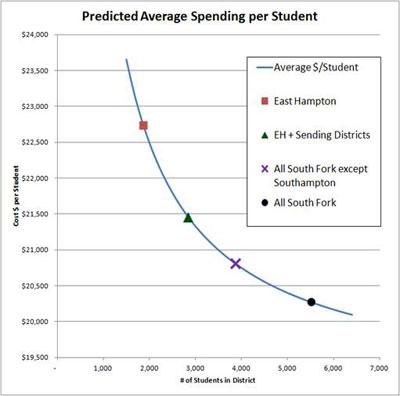Per-Pupil Costs Point To Consolidation

Reasons for combining all the public schools on the South Fork into one consolidated district — at least in terms of money — were described at a meeting of the East Hampton School Board Tuesday night.
The main conclusion of the district’s citizens advisory committee, after studying data for 2009-10, was that East Hampton spends more than the average school in Suffolk County — about 35 percent more.
Bill Grathwohl, who spent 20 years on Wall Street and represented the committee at the meeting, said East Hampton had an average cost per pupil of $30,702, compared to a regional average of $22,735.
The group had obtained New York State’s school report cards — which Mr. Grathwohl called “a wealth of information.” They compared East Hampton to other K-to-12 districts in Suffolk County and to schools of similar size in other areas. East Hampton’s costs, based on 1,871 children, were compared with districts that have between 1,000 and 2,000 students.
“We have no specific agenda,” Mr. Grathwohl stressed. “It’s purely an objective look, and we wanted to make sure the board is aware of it.”
East Hampton outdistanced the Southampton district somewhat; the Southampton per-pupil figure was $30,177. Mr. Grathwohl also reported on Sag Harbor and Bridgehampton’s per-pupil costs. Sag Harbor came in at $32,759, a few dollars over East Hampton, but tiny Bridgehampton’s per-pupil expense was $72,146.
A mathematical formula, called a regression model, leveled the playing field, he said. The average cost per student was arrived at by calculating the overall average for all districts ($19,011). To that was added an average of $7 million in fixed costs per district and the total was divided by the number of students in each district. The model came up with an average cost of $22,735 to educate a student in districts of between 1,000 to 2,000.
“This is not the cost of tuition,” Mr. Grathwohl pointed out. “This is the cost of everything in the school divided by the number of students.” He added that that “spending goes down in the larger schools.”
Other comparable schools in Suffolk, he said, have 10.7 students to 1 teacher; East Hampton has a 9.5-to-1 ratio. “If East Hampton were to follow that model,” Mr. Grathwohl said, “it would have 175 teachers instead of 196.”
However, Mr. Grathwohl also pointed out that student performance in Suffolk, as measured by a district’s average test scores, did not correlate with student-teacher ratios, spending, or size.
Using the regression model, the committee showed that by combining districts in some form, East Hampton could see a decrease in spending ranging from 6 to 11 percent per student. Decreases for smaller districts that would join East Hampton would be greater.
“There’s some noise in this data,” he acknowledged. “Another statistician could come up with a different set of numbers.”
Laura Anker Grossman, the president of the school board, thanked the committee. “We will look at this in greater detail and study it,” she said. “It was really helpful. We will continue this dialogue.”
East Hampton and the Springs School District already have agreed to study consolidation as part of their contract on tuition that Springs pays to East Hampton. Michael Hartner, the Springs superintendent, also has submitted an application for a grant to look at consolidation of six South Fork school districts and the Eastern Suffolk Board of Cooperative Educational Services.
During the meeting the board also continued to look at possible cuts to the 2012-13 budget, proving that no amount was too small to consider. A recommendation that the high school contribute $4,000 to the district’s sailing team for the rest of this year — an amount previously borne by the Ross School, which participates — was met with a round of questions by the board and a split vote.
After Alison Anderson, a board member, asked if the district could afford it, another board member, George Aman, called the sport “superfluous” and said it should be discontinued. “That money could go toward next year’s budget,” he said. The board voted to keep the program going for now, with Dr. Aman opposed.
“I’m voting for the children,” Liz Pucci, a board member, said. The team had already begun sailing in the fall. Ms. Anderson was clearly uncomfortable although she voted with the majority.
“We keep approving these wonderful things. What happens when we have to go back and take them away?”
“It’s a horrible situation we’re in,” agreed Ms. Pucci.
“This was very awkward,” Ms. Anderson said. “We should have known about this ahead of time.”
“You should have voted no,” Dr. Aman said.
On another topic, Arthur Goldman, a high school social studies teacher, wanted to clarify misinformation presented by a resident at a previous meeting and reported by The Star.
Paul Fiondella had raised questions about the teachers retirement system, comparing what he deemed the state’s overspending on pensions to the economic calamity in Greece. Mr. Goldman called his statements “inflammatory and false. Nothing could be further from the truth.”
Mr. Goldman said the independent Pew Center on the States had called New York’s pension fund one of the best managed in the country for two years in a row. “The average pension for a New York State employee is $19,000 a year,” Mr. Goldman continued. “The average for retirees from the teachers retirement system is $39,000.”
The board also recognized Cameron Yusko and Tania Urichima, the 2012 valedictorian and salutatorian, with a round of applause and a standing ovation for the students’ parents, who were in the audience.
And Richard Burns, the district’s interim superintendent, urged everyone at the meeting to visit Guild Hall’s student art exhibition. “The artistic expression is absolutely remarkable,” he said. “I was drawn into some of the works — they were stunning. What the teachers are doing here is unparalleled.”
